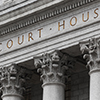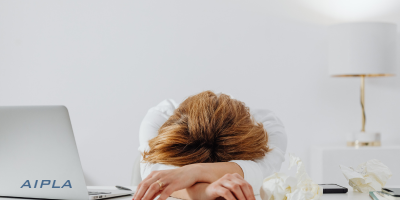Quarterly Journal 50-4
In This Section
 QJ 50.4 - The Birth of the Federal Circuit
QJ 50.4 - The Birth of the Federal Circuit
Judge Pauline Newman
Judge Pauline Newman reflects on the fortieth anniversary of the Federal Circuit and the fiftieth anniversary of the AIPLA Quarterly Journal. Telling the story of the Federal Circuit’s birth, Judge Newman recounts how far we have come, and far we have yet to go, as new sciences and technologies raise new legal issues.
 QJ 50.4 - Anniversaries and Observations
QJ 50.4 - Anniversaries and Observations
Chief Judge Kimberly Moore
Chief Judge Kimberly Moore celebrates the fortieth anniversary of the Federal Circuit by acknowledging the legacy of public service left by past and current Federal Circuit judges. She reflects on the growth of patent law since the AIPLA Quarterly Journal’s inaugural issue fifty years ago. Chief Judge Moore encourages the legal community to foster this growth by integrating patent law with the larger legal landscape.
 QJ 50.4 - Rethinking Progress
QJ 50.4 - Rethinking Progress
Director Katherine Kelly Vidal
Director Katherine Vidal reflects on the U.S. Patent and Trademark Office’s (“USPTO”) advances over the past fifty years. Heading into a future of modern technology and business practices paired with increased globalization, Director Vidal explains the job of the USPTO is to advance goals that will protect the public and lead to greater prosperity for our entire country.
 QJ 50.4 - Copyright Then and Now: A Half-Century of Change
QJ 50.4 - Copyright Then and Now: A Half-Century of Change
Register Shira Perlmutter
Since the publication of the first edition of the AIPLA Quarterly Journal more than fifty years ago, the copyright system has proved capable of adapting to tremendous, even revolutionary, challenges. The constitutional goals envisioned by the Framers, and the basic framework of rights and exceptions built over the years by Congress, were designed to be resilient and have continued their function of promoting creativity to the benefit of the public. This Article examines the copyright landscape in 1972 and developments in the decades that followed, identifying three major trends: the United States becoming a full participant in the international copyright and trade frameworks, the pervasive impact of digital technology, and expanded participation in both domestic and international debates. The Author concludes with a look forward, predicting that these trends will also shape copyright’s future and highlighting the role of the U.S. Copyright Office in ensuring that copyright remains a vital engine of creativity.
 QJ 50.4 - Fifty Years of Patent Law: The Top Ten Developments
QJ 50.4 - Fifty Years of Patent Law: The Top Ten Developments
Donald S. Chisum
Donald Chisum reviews the past fifty years of patent law, highlighting the top ten most significant developments. Chisum’s regular updates to his five-volume treatise on patent law, Chisum on Patents, reflects the growth of patent law since the treatise’s initial publication in 1978.
 QJ 50.4 - Fifty Years of Patent Remedies Case Law: Two Steps Forward, One Step Back
QJ 50.4 - Fifty Years of Patent Remedies Case Law: Two Steps Forward, One Step Back
Thomas F. Cotter
Over the past fifty years, courts have developed a body of case law on patent remedies that is, in many respects, solidly grounded in economic reasoning. Among the high points are the courts’ embrace, in various contexts, of the simple principle that patent damages should restore patent owners to the position they would have occupied, but for the infringement—and of an important corollary to that principle, namely the importance to damages calculations of the “noninfringing alternatives” concept. By contrast, certain other developments—including the confusing standards for determining when it is appropriate to use the “entire market value” of a product as the royalty base; the standards for awarding total profits for design patent infringement; and the intricacies of the patent marking statute—cry out for further judicial or legislative reform. Yet other developments, including the standards for granting injunctive relief (and, relatedly, for awarding ongoing royalties in lieu of injunctive relief); for calculating reasonable royalties; and for awarding enhanced damages, have in some respects been positive but could be further improved.
 QJ 50.4 - Fifty Years of U.S. Copyright: Toward a Law of Authors’ Rights?
QJ 50.4 - Fifty Years of U.S. Copyright: Toward a Law of Authors’ Rights?
Jane C. Ginsburg
In honor of the 50th Anniversary of the American Intellectual Property Law Association Quarterly Journal, this Article explores developments in U.S. copyright law within that timeline. Fifty years would take us to 1972, but the signal event in U.S. copyright law during that period is the 1976 Copyright Act, which took effect in 1978. I will examine how that law marks a watershed in U.S. copyright, shifting us toward a law of authors’ rights more consonant with the international standards of the Berne Convention on the Protection of Literary and Artistic Property. That said, U.S. copyright law and international norms still maintain an asymptotic relationship: U.S. law might approach a goal of authorial primacy, but its lack of moral rights and the persistence of vesting employers and certain commissioning parties with authorship status under the “works made for hire” doctrine ensure that the two lines of authority will never converge. At a more fundamental level, however, authors and authorship underpin the 1976 Act to a greater extent than its predecessors, starting with the statutory setting of creation as the point of attachment of federal copyright protection (rather than publication with proper notice of copyright). This Article will consider the respects in which the 1976 Act and its implementation, through to the recent interpretations of the Act to exclude non-human authorship, center copyright on creators. Part I addresses the relationship between creativity and formalities; Part II reviews copyright ownership; Part III examines the scope of protection of authors’ economic and moral rights; and Part IV addresses secondary authorship and the fair use defense. I conclude with some reflections on “authorless works” and why they cannot sustain copyrights under the 1976 Act.
 QJ 50.4 - Tom Irving’s Reflections on 47 Years in Patent Law, Starting in about the Third Year of APLA (now AIPLA)
QJ 50.4 - Tom Irving’s Reflections on 47 Years in Patent Law, Starting in about the Third Year of APLA (now AIPLA)
Tom Irving
Tom Irving reflects on his forty-seven years practicing and teaching patent law – recounting the evolution of the legal practice and AIPLA.
 QJ 50.4 - A Brief History of U.S. Trade Secret Law
QJ 50.4 - A Brief History of U.S. Trade Secret Law
James Pooley
This Article traces the path from common law to modern statutory frameworks which preserve the original emphasis on promoting ethical behavior by enforcing trust, while recognizing the trade secret owner’s “property” interest and the role of secrecy as in innovation incentive.
 QJ 50.4 - Fifty Years of Trademark Law: Where We Stand and What We Saw
QJ 50.4 - Fifty Years of Trademark Law: Where We Stand and What We Saw
Jane Shay Wald
Jane Shay Wald recounts the past fifty years of trademark law entirely in rhyme.
 QJ 50.4 - Classy, Bougie, Credit: TikTok Choreographers’ Fight Against Savage Copycats
QJ 50.4 - Classy, Bougie, Credit: TikTok Choreographers’ Fight Against Savage Copycats
Alexandra Smyrnios
This Note explains how the “patchwork” of moral rights laws has failed to protect oral rights in the context of TikTok choreography. TikTok has quickly risen to prominence as a leading social media platform, using its algorithm to determine how content is shared on the app and what goes viral. Dance trends make up a large portion of TikTok content, but unlike the credit given to the musicians making the songs, choreographers are rarely given credit for their work. These choreographers are then left with little recourse when their works are extensively copied by other users. TikTok’s Terms of Service, combined with existing U.S. law, leaves artists without their most basic right of attribution, as outlined by the Berne Convention. This Note argues that the current “patchwork” of U.S. laws governing moral rights must be corrected to comply with the Berne Convention, starting with amendments to the Visual Artists Rights Act (“VARA”). The proposed amendments include encompassing choreographic works and eliminating waivability of the right of attribution, providing TikTok choreographers with the ability to receive proper credit for their art.
 QJ 50.4 - Yours, Mine, or Ours: The Intersection Between Individuals and Biotechnology Entities Regarding Property and Compensation Rights and Biological Material Donations
QJ 50.4 - Yours, Mine, or Ours: The Intersection Between Individuals and Biotechnology Entities Regarding Property and Compensation Rights and Biological Material Donations
Khailee Marischuk
A major source of conflict in the biotechnology field is at the intersection of private personal property rights and the intellectual property interests of industry players. This problem most clearly arises when individuals donate biological materials, such as cell or samples, to researchers who then develop patentable inventions from those samples or are otherwise able to financially exploit the samples. In many cases, individuals feel that they have a vested property right in the patented or commercialized product as it would not have been created without their contribution, but the courts and the American legal system have repeatedly ruled in the contrary. This note explores the independent property rights of each party and examine the legal arguments proffered by the courts before offering possible reforms that acknowledge the contributions of the individual without undermining the values of the intellectual property law system at play.
 QJ 50.4 - Trademark Law Relies on Consumers, Consumers Rely on What?: Trademark Law and Its Heavy Reliance on Consumer Perception
QJ 50.4 - Trademark Law Relies on Consumers, Consumers Rely on What?: Trademark Law and Its Heavy Reliance on Consumer Perception
Min Kyoung Kim
Surveys are widely used with the belief that they capture unbiased, accurate results. In law school, students complete course evaluations for each course to provide feedback to professors and fellow students. Cognitive psychologists conduct and administer surveys to analyze the way the brain functions or to study the way humans engage in thought processes. In trademark law, applicants of a mark or litigants conduct consumer surveys to obtain consumer perception on their trademark. Even though survey use in trademark law is highly prevalent and routinely accepted and required by many courts, obtaining unbiased results is hardly achievable. Survey results can be biased and skewed due to multiple factors: human cognitive process, survey formats and questions, and poor handling of survey data. Though many concerns about survey evidence are present, the Supreme Court in United States Patent and Trademark Office v. Booking.com B.V. relied heavily on consumer perception in deciding whether the term “Booking.com” is generic. This Note explores consumer survey use in trademark law and argues too much reliance on consumer surveys can have harmful effects on future trademark registration system and litigations. Furthermore, this note argues for a reliable system and guidance to ensure protection of interests of mark owners and consumers.
Upcoming Events
-
.png?sfvrsn=9aa26827_1) 2026 AIPLA Virtual Corporate Practice Institute
2026 AIPLA Virtual Corporate Practice Institute
January 13 to 20, 2026 | Up to 360 Minutes of CLE
The Corporate Practice Institute is not a bootcamp. This program provides in-depth insight for in-house corporate counsel and agents to learn about wide ranging legal issues affecting their practice from experienced practitioners. It is designed for experienced in-house attorneys and new in-house attorneys learning to manage new corporate environments and challenges not taught in law schools or private practice. The Institute also helps private practice attorneys, especially associates, prepare for potential in-house career moves. The program also provides valuable networking opportunities to connect with each other and learn from each other's experiences. This online, CLE-program spans two half-days, from Noon – 5:00 pm Eastern and includes 3 one-hour education sessions and a networking session each day. -
 AIPLA CLE Webinar: Regulation, Risk & Resilience: The Nexus Between Professional Liability, Duty of Competence & Practitioner Well-Being
AIPLA CLE Webinar: Regulation, Risk & Resilience: The Nexus Between Professional Liability, Duty of Competence & Practitioner Well-Being
February 10, 2026 12:30 PM to 2:00 PM | Eligible for up to 90 Mins CLE
Mental health issues and substance use disorders can affect any practitioner, in any setting, and at any time. Left untreated, they can destroy careers and lives. This program will discuss where the legal profession currently stands in relation to the substantial challenges presented by untreated mental health issues and substance use disorders and examine the nexus between ethical competence under the USPTO Rules of Professional Conduct and practitioner well-being. This program will educate attendees on how to recognize the signs of an impaired attorney, how to approach the colleague and begin a conversation, and discuss the possible disciplinary and professional liability implications of an impaired practitioner’s conduct. In addition, the speakers will present best practices/effective risk management strategies, preventative measures, and proposed policy and well-being initiatives, that practitioners in any practice setting may implement to protect clients, themselves, and other firm members as well as save careers. -
.png?sfvrsn=fb5905da_1) 2026 IP Transactions Bootcamp
2026 IP Transactions Bootcamp
February 12, 2026
This in-person bootcamp is designed to provide practical insights and strategies for professionals working in intellectual property transactions. The day features a comprehensive agenda including: Panels and CLE Sessions: Learn about Working with Tech Transfer Offices, Strategies for successful collaborations between nonprofits and industry, and Protecting and monetizing an AI asset. Drafting and Negotiating Tips: Get practical advice on drafting and negotiating strategic collaboration and license agreements. Hands-on Workshop: Participate in a Mock licensing negotiation to put your skills to the test. Networking: Conclude the day with a dedicated Networking reception. -
-(1).png?sfvrsn=7a1054_1) 2026 Trade Secret Summit
2026 Trade Secret Summit
March 26 to 27, 2026
The AIPLA Trade Secret Summit is the leading trade secret conference in the nation, with speakers from across the spectrum of private practitioners, in-house counsel, government, and academia, as well as fantastic networking opportunities. CLE credits will be available. -
2025 Women in IP Global Networking Event
April 16, 2026

